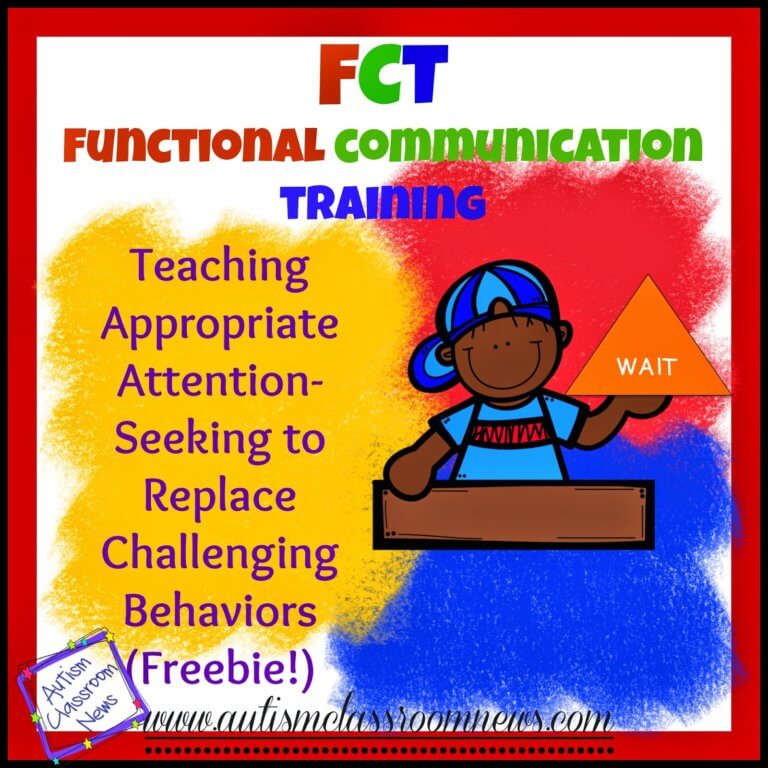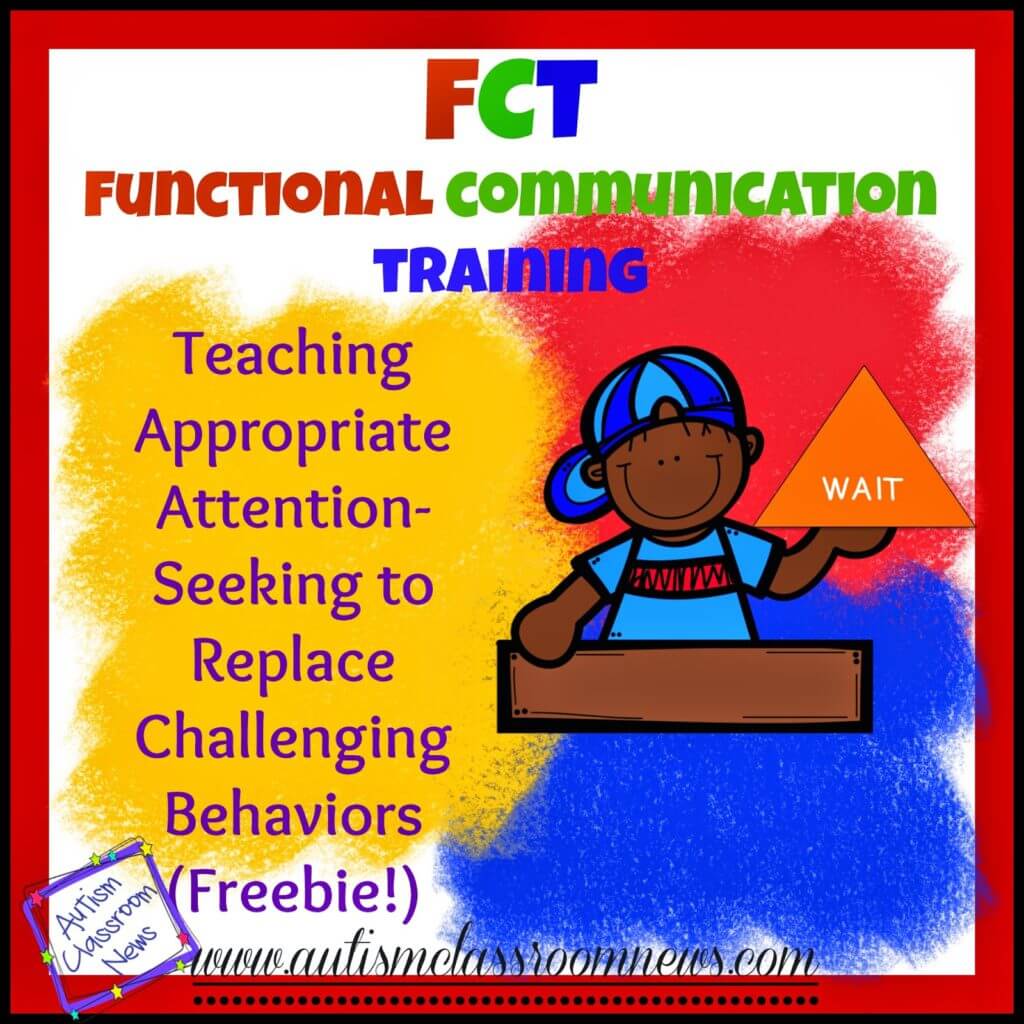When we talk about teaching replacement behaviors for attention seeking to reduce challenging behaviors, it’s important that we set it up to be successful. The three most common applications are teaching attention seeking, teaching escape behaviors, and teaching requesting items and actions (for the tangible function). Today I want to talk about how to teach an individual to use an appropriate communicative way to gain attention from others. You can teach students to gain attention in a variety of ways from telling jokes, initiating interactions in play, and initiating conversations among others. These work well for students who have some communication skills but aren’t using them effectively. I want to focus today more on the student who does not have effective communicative ways to gain attention. They might be nonverbal and have limited communication skills or they might be verbal but not use their language effectively or communicatively (like the kid who recites the newscast but can’t ask for a banana). These are the students who need the basics of communication specifically focused on gaining the attention that their challenging behavior currently serves. Obviously this is something you would use for students whose FBAs indicated attention as a primary function of challenging behavior. I am going to give you the highlights and then I have included a free download of a protocol with more details about how to set it up.
Let me first make a disclaimer that if you have never done this before, I highly recommend collaborating with a behavior analyst and/or speech pathologist who can help you set it up to be successful. This protocol provides some guidance for teaching but it isn’t meant to replace working with someone skilled in behavioral principles to help guide you through the process. And now, let’s get on with it.
Choose the Communicative Form
Identify a communication mode that will be quick for the person to use and easily understandable to those you want to communicate with him (e.g., picture or word on a communication board; raising his hand; tapping your shoulder). If you can choose a form that the individual already has in his or her repertoire–something he/she already does.
Setting for Initial Teaching
Establish a teaching situation of a short one-to-one work period (e.g., 15 minutes) in which the individual can gain your attention an indefinite number of times without disturbing other children. It might be helpful to have this situation include a task that you expect the individual to complete independently while you do work at the table such as making materials for the next task. This will provide opportunities for the child to get your attention.
If the FBA results indicate that attention-seeking challenging behaviors occur primarily when you are working with another student, you might add the student to the work setting. Just be careful to assure his/her safety when doing so.
Remember that although you might say you are working, don’t expect to get much work done. Your time is going to be spent prompting and reinforcing communication. The “work” you are attending to is really just a ruse to pull your attention away.
Teaching the Child the Communication Skill
Begin the task by explaining (BRIEFLY) to the individual that when she uses the communication (e.g. taps your shoulder) you can talk to her. Then present her with the task and begin your own work. A social story might be helpful like the one I’ll reference below.
Based on your knowledge of the individual, try to predict when behavior problems will begin. If the child typically must have your attention 100% of the time and cannot do any independent work, prompt the child to communicate with you for your attention immediately after telling him it is time to work. If the child can typically do a small amount of independent work, watch for signs that she is becoming agitated or looking to you to see what your response will be. Prompt her at this time to communicate and then give lots of attention.
The key is to try to catch the individual BEFORE the behavior problems begin, prompt her to use the sign, and then reinforce her with the type of attention she seems to like. Prompt her to communicate for attention as immediately as possible after sitting down so that she can begin to learn the association between the communication and the response.
Responding to Requests
Respond to requests for attention by giving high affect attention that the FBA indicated is what the student is gaining with the behavior. For instance, if he or she gets people to stop and stare and talk to him to reprimand him for his behavior, try using high affect praise with lots of talking about what he did well. Take an interest in what he is doing when he asks and talk about it for a few seconds.
Attention doesn’t necessarily need to be long or drawn out, but it needs to be sufficient to meet the individual preferences of the student. Your hypotheses statements from your FBA should give some indication of what attention to the negative behaviors look like to guide you in creating replacements.
After the Request and Response
Turn back to your work and give a simple reminder (e.g., “Remember to call my name if you want to talk to me.). Then go back to work and repeat the process. Repeat this multiple times for several sessions, fading your prompting out so that the student becomes more independent at making the request.
Think of your sessions like your math or reading sessions but you are providing explicit instruction in communication. The more opportunities to practice, the faster the skill will be acquired. You can do this repeatedly for 10 to 15 minutes in a session as long as the student is engaged with the activity. If it becomes too frustrating, lessen the times but schedule more shorter sessions each day.
Teaching Delays
When the individual begins to use the attention request consistently and independently, you can begin to teach her to wait a short time before attending to her. This should be done very gradually. That is, tell the person, “Thanks for asking. I’ll talk to you in a second.” Wait, literally no more than a few seconds, and then give enthusiastic praise for both waiting and for communicating. Gradually increase the time you ask the student to wait as they are successful.
Do not require the student to ask for attention again before giving it. This just teaches that the first time wasn’t effective and will undermine the teaching.
You can use a wait card to help the student understand that you are changing the rules. The wait card would be given as soon as you ask him to wait and then you take it back when waiting is over. I would make the wait card something that looks different than other communication visuals to differentiate it for the student. I’ve included one in the new set of social narratives described below that is an orange triangle.
Generalization
Once the student is able to wait for short periods of time, start to encourage the communication for attention outside of the instructional setting, if it hasn’t already occurred. If the student uses the attention-seeking communication outside of the setting at any time, make sure to reinforce it strongly.
So, do you have a student whose functional behavior assessment indicates that the challenging behaviors appear to gain attention? If so, I hope this is has been helpful for you. You can download the more detailed protocol for teaching HERE. In addition, I have created social narratives and visual supports to help introduce the instruction to students or help students who already have some appropriate and functional communication but who aren’t using it effectively to gain attention.








